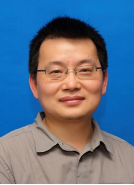
- Keynote Speakers
-

Jianrong Tan
Academicians of Chinese Academy of Engineering
Head of Department of Design Engineering and Automation, School of Mechanical Engineering, Zhejiang University
Mechanical engineering experts, master of engineering and doctor of science, distinguished professor of Zhejiang University. Mainly engaged in mechanical design and digital manufacturing research, and put forward the combination of batch and custom mass customization design technology, engineering transition state, fuzzy state, random state model and digital prototype integrated simulation technology, combination of numerical and geometric complicated equipment multi-unit association, multi-level configuration and parameter matching analysis technology, won 7 national awards, including national science and technology progress second prize 4 items, the national outstanding teaching achievements first prize 1 item, second prize 2 items, awarded provincial scientific and technological progress first prize seven items; Put into use the proposed technique in software, develop and access 12 computer software copyright which have successful applications in a number of manufacturing enterprises. Published 8 books, 142 papers in SCI/EI.
Title: 人工智能与知识工程:关键技术与发展趋势
-

Qiang Yang
Chair Professor, Department of Computer Science and Engineering, Hong Kong University of Science and Technology
AAAI/ACM/IEEE/CAAI/AAAS Fellow
Chief AI Officer, WeBank
Qiang Yang is a Fellow of Canadian Academy of Engineering (CAE) and Royal Society of Canada (RSC), Chief Artificial Intelligence Officer of WeBank and Chair Professor of CSE Department of Hong Kong Univ. of Sci. and Tech. He is the Conference Chair of AAAI-21, President of Hong Kong Society of Artificial Intelligence and Robotics(HKSAIR) , the President of Investment Technology League (ITL) and a former President of IJCAI (2017-2019). He is a fellow of AAAI, ACM, IEEE and AAAS. His research interests include transfer learning and federated learning. He is the founding EiC of two journals: IEEE Transactions on Big Data and ACM Transactions on Intelligent Systems and Technology. His latest books are TransferLearning ,Federated LearningandPracticing Federated Learning.
Title: Data Elements and Federated Learning
Abstract: AI is advancing by leaps and bounds in learning algorithm development, but AI has many challenges when put to practice. One of the major challenges faced by AI is the serious lack of data, which has led to the inability of many good algorithm models to be effectively applied. In this talk, I will present federated learning as a solution designed to connect data silos while protecting user privacy and provide security. I will illustrate some theoretical advances and practical applications.
-

Nadia Magnenat Thalmann
Founder and Director of MIRALab, University of Geneva,
Director of the Institute for Media Innovation (IMI), Nanyang Technological University
Editor-in-Chief, Visual Computer
Co- Editor-in-Chief, Computer Animation and Virtual Worlds
Professor Nadia Magnenat Thalmann is a computer graphics scientist and a robotician and is the founder and head of MIRALab at the University of Geneva. She chaired the Institute for Media Innovation at Nanyang Technological University (NTU), Singapore until July 2021. She is a life member of the Swiss Academy of Engineering Sciences.
Thalmann has authored and co-authored more than 600 papers in the area of Virtual Humans, social robots, VR, AR, and 3D simulation of human articulations. She has participated in more than 45 European Research projects and has initiated quite a few. She has served the Computer Graphics community by creating the Computer Animation and Social Agents (CASA) Conference as well as the Computer Graphics International Conference (CGI) in Geneva, both of which are internationally well known yearly conferences. She is the editor-in-chief of the journal The Visual Computer published by Springer, Germany and co editor-in-chief of the Computer Animation Journal published by Wiley, UK.
Title: What makes a robot behave intelligently? A description of the complexity of both the hardware and the software and their integration.
Abstract: During the first decade of the 20th Century, we have worked on developing social intelligent behaviour for virtual humans and humanoid robots. Our first humanoid robot Eva was able to interact with people, recognize faces, keep some facts in memory and show expressions according to the dialog. Even it if did not use AI methods as today, a user study showed that people found her somehow intelligent…
During these last 8 years, we have developed several modules for another humanoid social robot Nadine, that allow the robot to behave in a believable way.
What is social intelligence for robots? How can we give the illusion that during a dialog and interaction, a robot is trustable and socially intelligent?
A discussion on the performance of the hardware as for example the hand, the realism of the face and body, the various facial expressions, the variation of the tone while speaking, the use of several deep learning methods for the recognition of faces, gestures, will be presented. We will show a few case studies where Nadine has worked as a customer agent in an assurance company , or more recently in an elderly home.
-

Cheng-Lin Liu
Director, National Laboratory of Pattern Recognition (NLPR)
Vice President, Institute of Automation of Chinese Academy of Sciences
Vice Dean, School of Artificial Intelligence, University of Chinese Academy of Sciences
IEEE/CAAI/IAPR Fellow
Cheng-Lin Liu is a Professor at the National Laboratory of Pattern Recognition, Institute of Automation of Chinese Academy of Sciences, and now the Director of the Laboratory. He received the PhD degree in pattern recognition and intelligent control from the Chinese Academy of Sciences, Beijing, China, in 1995. He was a postdoctoral fellow in Korea and Japan from March 1996 to March 1999. From 1999 to 2004, he was a researcher at the Central Research Laboratory, Hitachi, Ltd., Tokyo, Japan. His research interests include pattern recognition, image processing, neural networks, machine learning, and especially the applications to document analysis and recognition. He has published over 300 technical papers at journals and conferences. He is an Associate Editor-in-Chief of Pattern Recognition Journal and Acta AutomaticaSinica, an Associate Editor of International Journal on Document Analysis and Recognition, Cognitive Computation, IEEE/CAA Journal of AutomaticaSinica, and CAAI Trans. Intelligence Technology. He is a Fellow of the CAA, the CAAI, the IAPR and the IEEE.
Title: Robust Pattern Recognition in Open World
Abstract: In recent years, deep learning methods achieved huge successes in pattern recognition, but the popular deep neural networks show poor robustness to noise and outlier in open world,and serious forgetting in incremental learning. In this talk, I first explain the robustness of pattern recognition, list the related research issues of robust pattern recognition, and introduce some methods for improving the robustness for open set recognition, which needs to both classify within-class patterns and reject outlier. In particular, I will introduce a newly proposed deep learning method for robust recognition: convolutional prototype network (CPN). The CPN uses a prototype classifier for classification, and learns convolutional feature space and prototypes jointly to yield high accuracy for both classification and outlier rejection. We show that CPN performs well in open set recognition, incremental learning and adversarial robustness.
-

Gang Pan
Professor, College of Computer Science and Technology, Zhejiang University
Vice Director, State Key Lab of CAD&CG, Zhejiang University
Gang Pan is a professor of the College of Computer Science and Technology, and vice-director of State Key Lab of CAD&CG, Zhejiang University. He received the B.Eng. and Ph.D. degrees from Zhejiang University in 1998 and 2004 respectively. His interests include artificial intelligence, brain-inspired computing, brain-machine interfaces, and pervasive computing. He has co-authored more than 100 refereed papers, and has 41 patents granted. Dr. Pan is a recipient of NSF for Distinguished Young Scholars (2019), IEEE TCSC Award for Excellence (Middle Career Researcher, 2018), CCF-IEEE CS Young Computer Scientist Award (2016). He has received many technical awards, including TOP-10 Achievements in Science and Technology in Chinese Universities (2016), National Science and Technology Progress Award (2015), Best Paper Award of ACM UbiComp'16, IEEE UIC Test-of-Time Paper Award (2019), People's Choice Best Paper Award of IEEE CVPR'15, and 2016 BCI Research Award Nomination. He serves as an associate editor of IEEE Trans. Neural Networks and Learning Systems, IEEE Trans. Cybernetics, IEEE Trans. Cognitive and Developmental Systems.
Title: Cyborg Intelligence: Towards the Convergence of Machine and Biological Intelligence
Abstract: Recent advances in the multidisciplinary fields such as brain-machine interfaces, artificial intelligence, and computational neuroscience, signal a growing convergence between machines and living beings. Brain-machine interfaces (BMIs) enable direct communication pathways between the brain and an external device, making it possible to connect organic and computing parts at the signal level. Cyborg means a biological-machine system consisting of both organic and computing components. Cyborg intelligence aims to deeply integrate machine intelligence with biological intelligence by connecting machines and living beings via BMIs. This talk will introduce the concept, architectures, and applications of cyborg intelligence. It will also discuss its issues and challenges. Our recent progresses in this field will be presented.
-

Liang Yan
Professor, School of Automation Science and Electrical Engineering, Beihang University
Liang Yan is Changjiang Distinguished Professor of Beihang University. His interest is mainly on high-performance actuation and its applications. He has conducted research projects from Natural Science Foundation of China, National Key Research and Development Program, National Science and Technology Innovation Program etc. He is the electrical machine committee member of IEEE Industrial Electronics Society, the robotics and mechatronics committee member of IFToMM, and the mechatronics committee member of Chinese Aeronautics Society.
Title: Development of Multi-DOF Spherical Actuator
Abstract: With the progress of aerospace technology, the conflict between the output-performance improvement and the structure compactness becomes significant. The major challenge to solve this problem is the utilization rate of electromagnetic field in three-dimensional (3D) space. So far, 2D magnet arrays are widely employed for electromagnetic actuation. The low utilization rate of magnetic field avoidably constrains the improvement of system output performance. Therefore, the improvement of utilization rate of magnetic field and its intensity is the key solution to increase the actuation capability. This talk will mainly focus on electromagnetic actuation technology, and introduce the operating principle of complex 3D space magnetic field of actuators.
-

David Woodruff
Associate Professor, Carnegie Mellon University
David Woodruff joined the algorithms and complexity group at IBM Almaden in 2007, after completing his PhD at MIT in Theoretical Computer Science. He is currently an Associate Professor of Computer Science at Carnegie Mellon University. His interests are in compressed sensing, communication, numerical linear algebra, sketching, and streaming. He is the recipient of the Presburger Award and Simons Investigator Award, as well as best paper awards at STOC, 2013 and PODS 2010 and 2020. Earlier he was in the IBM Academy of Technology and a Master Inventor.
Title: An Overview of Big Data Techniques
Abstract: We give an overview of dimensionality reduction methods, or sketching, for a number of problems in optimization, first surveying work using these methods for classical problems, which gives near optimal algorithms for regression, low rank approximation, and natural variants. We then survey recent work applying sketching to column subset selection, kernel methods, sublinear algorithms for structured matrices, tensors, trace estimation, and so on. The focus in the talk will be on fast algorithms.
